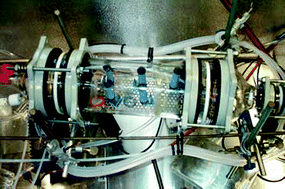Laboratory and field validation of a combined NO2–SO2 Radiello passive sampler†
Abstract
A combined NO2–SO2 Radiello radial-type diffusive sampler was validated under controlled laboratory conditions and compared with NO2–SO2 results of 3 other type of samplers in a field comparison at two locations Ghent-Mariakerke and Borgerhout in Flanders. Laboratory exposures at different temperatures (−5, 10 and 30 °C) and relative humidities (0, 50 and 80% RH) in combination with varying concentration levels and exposure times were carried out, with a focus on extreme conditions. Concentration level and exposure time were changed together following suppliers linear working range of samplers and assuring absolute amounts of compounds on the sampler corresponding to those of environmental levels. The average uptake rate for NO2 for 24 hour exposures at 10 °C and 50% RH and tested concentration levels (±73, 146 and 293 ppb NO2) was 0.076 ± 0.011 ng ppb−1 min−1. Uptake rates during all experiments were lower than the uptake rate given in the instruction manual of the sampler. A significant effect of temperature and relative humidity on NO2 uptake rate was observed. The temperature effect from 10 to 30 °C corresponds to the temperature effect given by the supplier of the samplers. High relative humidity (70 to 80%) caused a strong non-reproducible decrease of uptake rate for NO2 at 24 hour experiments but this effect was not observed at longer exposures except for the tests at −5 °C. At the tested temperature below zero in combination with high relative humidity the sampler showed anomalous behaviour for NO2. The possible effect of concentration level and exposure time for NO2 needs further research. The average uptake rate for SO2 calculated from all exposures is 0.478 ± 0.075 ng of sulfate ion each ppb min of SO2 and accords to suppliers uptake rate. No clear effects of temperature, relative humidity or concentration level/exposure time on the uptake rate for SO2 were found, partly due to the large scatter of results. Although NO2 accuracy of Radiello samplers was better during field campaigns than during laboratory validation, IVL and OGAWA samplers gave better results for NO2. In the field, IVL samplers showed best agreement with the continuous analyzers for both NO2 and SO2.


 Please wait while we load your content...
Please wait while we load your content...